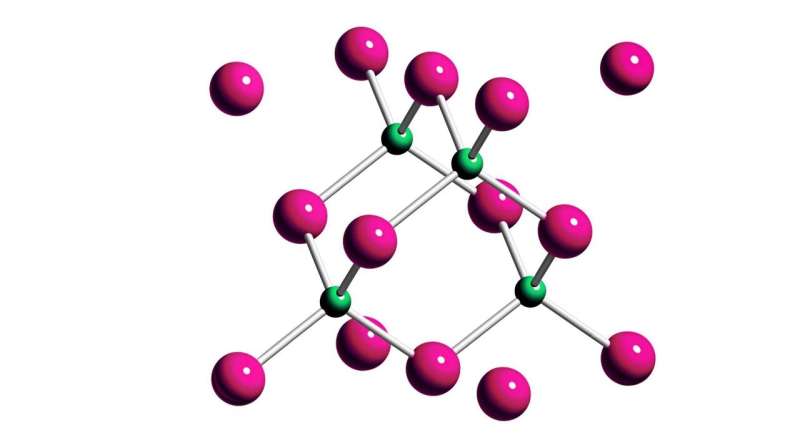
August 6, 2024 by Nicolas Posunko, Skolkovo Institute of Science and Technology
Collected at: https://phys.org/news/2024-08-method-atomic-materials.html
Researchers from Skoltech, Ural Federal University, and Mikheev Institute of Metal Physics, UB RAS, have furnished a fundamental theoretical description of important properties of chemical bonding in materials—namely, the atomic charges and the partitioning of chemical bond energy into ionic and covalent contributions.
The research paper provides a compelling groundwork for the traditional picture based on the notion of electronegativity. That said, the study also identifies an anomalous and counterintuitive case: the semiconducting boron phosphide. The findings are reported in The Journal of Chemical Physics.
Since the early 20th century, scientists have sought to explain the properties of molecules and crystals in terms of chemical bonds—the attractive interactions between the atoms due to some underlying behavior of their valence electrons.
Various types of bonds came to be discovered. In a covalent bond, for example, two atoms share an electron pair that holds them together. You can have more than two atoms sharing, and when very many atoms are involved, the bond is called metallic.
The opposite case, where two or more electron pairs are shared between two atoms, is also known. It is also possible for the shared electron pair to shift toward the stronger-pulling atom so much as to form two oppositely charged ions held together by an ionic bond—the extreme case of a polar covalent bond.
“Consider a bond that holds together the atoms in a material. The degree to which that bond is covalent or ionic, and therefore the charges of the atoms, will affect most of the material’s properties,” said study co-author Distinguished Professor Artem R. Oganov, who heads the Material Discovery Laboratory at Skoltech.
“The problem is that over the past century, so many ways to define atomic charges have been proposed that there’s no agreement on what we’re talking about and what the actual numeric values are.”
Some approaches define atomic charges in terms of observable material properties, such as the amount of energy required to break bonds. Others rely on the mathematical operation of integrating the electron density distribution over the volume of the atom, the latter not unequivocally defined, either.
Yet other approaches work with the wave functions—fundamental yet unobservable quantum-mechanical objects. Here, too, there are numerous ways to analyze the wave function.
“Our own method, whose chief creator is Vladimir Anisimov, a renowned condensed matter physicist, uses the formal mathematical description of the so-called Wannier functions to stand in for electronic orbitals in the crystal or molecule in terms of atomic-like wave functions,” Oganov said.
“The method allows the atomic charges and the degree of bond covalency vs. ionicity to be determined in a nonempirical way. The findings agree well with a chemist’s general intuition, but the atomic charges extracted for the boron phosphide (BP) crystal are unexpectedly ‘inverted.'”
A similar phenomenon is known to occur in the carbon monoxide (CO) molecule, comprised by one atom of oxygen and one atom of carbon. With its higher electronegativity, oxygen could be expected to have a stronger pull on the shared electron pair, resulting in a negative charge on oxygen and a positive charge on carbon.
In reality, the situation is reversed. The situation is similar to the case of boron phosphide: despite phosphorus having higher electronegativity than boron, the latter ends up with a negative charge. Why would that happen?
In both cases, the explanation is that the atoms seem to put up with an energetically unfavorable step, whose ultimate tradeoff is securing a stronger covalent bonding that makes this whole move energetically worthwhile.
In carbon monoxide, the charge inversion enables a very strong triple bond between oxygen and carbon. If it weren’t for that “lesser energy sacrifice,” only a double bond would be viable.
Similarly, by donating one of phosphorus’s electrons to boron, the two atoms effectively have four valence electrons each at their disposal to build four covalent bonds with their neighbors in the crystal structure. Otherwise, both boron and phosphorus would only be able to enjoy three bonds per atom, which is ultimately less energetically favorable.
Interestingly, such charge inversion in boron phosphide was predicted two decades ago in so-called Born dynamical charges. While those were charges of a physically very different kind, it looks like something’s clearly “backward” about the boron-phosphorus system.
The method proposed by the researchers is universal, so it will enable a better understanding of the nature of chemical bonds in all sorts of compounds.
More information: Vladimir I. Anisimov et al, First-principles definition of ionicity and covalency in molecules and solids, The Journal of Chemical Physics (2024). DOI: 10.1063/5.0202481
Journal information: Journal of Chemical Physics

Leave a Reply